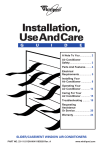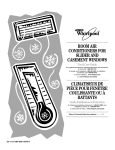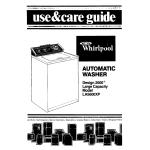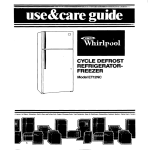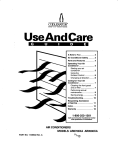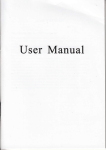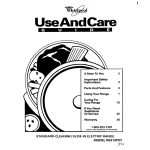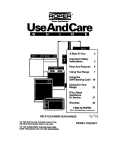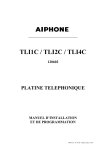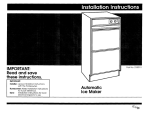Download Whirlpool ACS072XG User's Manual
Transcript
A JOB WELL DONE? Installation, Use And Care A Note To You . . . . . . . . . . . . . . . .2 Air Conditioner Safety . . . . . . . .. . . . . . . . . . . . . .. . .. .. . .3 Parts And Features Electrical Requirements . . . . ...4 .. . . . . . . . . . . .. . .5 Installing Your Air Conditioner . . . . . . . . . . . . . .7 Operating Your Air Conditioner . .. . . . . . . . .. 12 Caring For Your Air Conditioner . .. . . . . . . . . . 14 Troubleshooting Requesting Assistance Or Service Warranty . . . . . . . . .. 17 . . . . . .. . . . . . . . . . . .. . 18 . .. . . . . .. . .. . . . . . . . . ..20 1-800-253-1301 Call Our Consumer Assistance Center with questions or comments or visit our website at... www.whirlDool.com. SLIDER/CASEMENT PART NO. 23-ll-2112N-001/789771 - WINDOW AIR CONDITIONERS MODELS ACS072XG ACS102XG s-%3 A Note to You Thank you for buying a WHIRLPOOL@ appliance. Because your life is getting busier and more complicated, WHIRLPOOL Air Conditioners are easy to use, save time, and help you manage your home better. To ensure you enjoy years of trouble-free operation, we developed this Use and Care Guide. It contains valuable information about how to operate and maintain your appliance properly and safely. Please read it carefully. Also, please complete and mail the Ownership Registration Card provided with your appliance. This card helps us notify you about any new information on your appliance. Please record your model’s information. Whenever you call to request service on your appliance, you need to know your complete model number and serial number. You can find this information on the model and serial number label (see diagram on page 4 for location of label). Please also record the ourchase date of your appliance and your dealer’s name, address, and telephone number. Keep this book and the sales slip together I Model Number Serial Number Purchase Date Dealer Name Dealer Address Dealer Phone in a safe place Our Consumer Assistance Center number is toll-free 24 hours a day. for future 1-800-253-I reference. 301 To find detailed product information, the location of the nearest Whirlpool dealer or authorized servicer; to purchase an accessory item, or register your appliance on-line, please visit our website at... www.whirlpool.com. 1 Air Conditioner Your safety and the safety Safety of others is very important. We have provided many important safety messages in this manual and on your appliance. Always read and obey all safety messages. This is the safety alert symbol. This symbol alerts you to hazards that can kill or hurt you and others. All safety messages will be preceded by the safety alert symbol and the word “DANGER” or “WARNING.” These words mean: All safety messages will identify the hazard, tell you how to reduce the chance of injury, and tell you i what can haDDen if the instructions are not followed. IMPORTANT SAFETY INSTRUCTIONS WARNING -To reduce the risk of fire, electric shock, injury, or sickness when using your air conditioner, follow these basic precautions: . Use two or more people to move or l Plug into a grounded 3 prong outlet. install air conditioner. l Do not remove ground prong. . Do not drink water collected inside the l Do not use an adapter. cabinet. l Do not use an extension cord. l Unplug air conditioner before servicing. Help us help SAVE THESE INSTRUCTIONS- you Please: l Install your air conditioner in a window that will hold the weight, and secure the air conditioner according to the Installation Instructions. l Connect the air conditioner to the proper kind of outlet with the correct electrical supply and ground. (See the Installation Instructions.) l Make sure the air conditioner is the correct size for the area you want to cool. Use the air conditioner only to do what a window air conditioner is designed to do. l Make sure the air conditioner is not used by anyone unable to operate it properly. l Maintain the air conditioner properly. Also, remove the Energy Label. Use a damp cloth to take off any glue residue. DO NOT use sharp instruments, flammable fluids, or abrasive cleaners. These can damage the material. l 3 Parts And Features This section contains captioned illustrations of your air conditioner. Use them to become familiar with where all parts and features are located and what they look like. To help you find information on specific parts or features quickly, page references are included. Model and serial number plate ind air louvers) Removable front panel (P- 14) Removable air filter (behind panel) Control Panel / EXHAUST CONTROL -ii FAN CONTROL cjg@L 1HERMOSTAT Q) “& I Exhaust vent control 4 Fan control Thermostat control Electrical Requirements Electrical receptacle variations are shown on page 6; choose the one which matches the ampere rating of your air conditioner. Your model’s ampere rating is printed on the model and serial number label, located behind the front panel. (See diagram on page 4.) Electrical Shock Hazard Plug into a grounded 3 prong outlet. Do not remove ground prong. Do not use an adapter. Do not use an extension cord. Failure to follow these instructions can result in death, fire, or electrical shock. Observe all local codes and ordinances. Do not, under any circumstances, remove the power supply cord ground prong. NOTE: If codes permit and a separate ground wire is used, it is recommended that a qualified electrician determine that the ground path is adequate and not interrupted by plastic, non-metallic gaskets or other insulating materials. Check with a qualified electrician if you are in doubt as to whether the air conditioner is properly grounded. 5 ELECTRICAL PLUG TYPE REQUIREMENTS 115-volt models with amperes up through 7.5 115-volt models with amperes from 7.6 to 12.0 Receptacle wiring Receptacle wiring should be a minimum of 14 gauge. Use copper wire only. It is the responsibility of the consumer to provide proper and adequate receptacle wiring, installed by a qualified electrician. Observe national electrical codes and all local governing codes and ordinances. Electrical connection Electrical ground is required on this air conditioner. Recommended ground method For your personal safety, this air conditioner must be grounded. This air conditioner is equipped with a power supply cord having a 3-prong ground plug. To minimize possible shock hazard, the cord must be plugged into a mating 3-prong ground-type wall receptacle, grounded in accordance with the National Electrical Code ANSVNFPA 70 - latest edition and local codes and ordinances. If a mating wall receptacle is not available, it is the responsibility of the customer to have a properly grounded 3-prong wall receptacle installed by a qualified electrician. 6 Electrical requirements A 115~volt (103.5 min., 126.5 max.), 60-H& AC-only, 15-ampere fused electrical supply is required. A time-delay fuse or circuit breaker required. It is required that a separate circuit, serving only this air conditioner, be provided. Installing Your Air Conditioner Preparing for installation Tools l Excessive Weight Hazard Use 2 or more people to move and install air conditioner. Failure to do so can result in back or other injury. l l l l l l l Installation required Flat-head screwdriver Carpenter’s level Tape measure Electric or hand drill M-inch drill bit Pencil Awl Knife tips 1. Choose a proper size window. l 15-W inches minimum width l 22 inches minimum height l 42 inches maximum height NOTE: The height measurement must be of an unobstructed opening above the mounting platform. In some cases, due to a variety of stop and track arrangements, the above dimensions may vary slightly. 2. Choose the installation site. The window frame and side of the structure must be able to support at least 110 Ibs. of weight. 3. Choose the proper window location. Choose a window that will allow the cooled air to flow freely and directly into the room(s) you want to cool. Remember, it is difficult to move air around corners. Also, choose a window that is within 6 feet of an electrical outlet. (See “Electrical Requirements” on pages 5-6 for receptacle and wiring requirements.) Do not use an extension cord. A 15-W inches minimum width 22 inches minimum height 42 inches maximum Installing in a sliding NOTE: This air conditioner must be installed according to all applicable codes and ordinances. 1. Slide open or remove one sliding window sash from the window frame. 2. Attach support platform to sill plate with three 3/a”-long self-tapping screws. 3. Thread locknut to about the middle of the leveling bolt. 4. Thread leveling bolt into support angle. The leveling bolt will be adjusted later. 5. Loosely attach the support angle to the bottom Of the SUDDOrt DkItfOrrt7 USinCl two 7/l 6”-long &&hi& screws, flatwashers, and nuts. window 3/E”-long self-tapping screws 7A 6”~long Self-tapping 6. Place the support platform assembly against the lower window track and firmly against the vertical edge of the . window trame. 7. Attach the support platform assembly to the window stool using two selftapping screws. Tighten screws securely. 8. Pull the support angle toward the outside of wall. Tighten 7/l6”-long machine screws on top of the support platform. / I screw platform assembly I Lower window track continued 8 on next page 9. Adjust the leveling bolt until support angle is level. Tighten the leveling bolt locknut. This allows air conditioner to tilt back slightly for proper condensate disposal. NOTE: Be sure the window track is securely attached to the building construction. Use longer screws into the subframing if necessary. Do not drill a hole in the bottom pan. The air conditioner is designed to operate with approximately W’ of water in the bottom pan. 10. Cut two pieces of adhesive back foam seal equal to the height of the Top retainer (Step 17) Filler panel (Step 17) Foam seal window opening. Remove backing and apply to the vertical inside edges of the window frame and sliding sash that will rest against the air conditioner. 11. Replace the sliding sash in the window frame. Foam seal Channel 9 12. Slide the air conditioner onto the support platform assembly. Be sure the air conditioner side channel butts against the vertical edge of the window frame. Watch out for the sharp metal fins on the front and rear coils. NOTE: If air conditioner side channel does not fit securely, remove air conditioner and readjust leveling bolt. 13. Using the existing clearance holes in the air conditioner bottom flange as guides, drill two V8” holes through the window channel frame. Install two self-threading screws through the clearance holes and into these holes. Tighten the screws securely. The air conditioner should be firmly anchored to the window channel frameNOTE: Be sure your air conditioner does not fall out during installation. 14. Slide the inside window sash closed. Make sure the vertical edge of the inside window sash is pressed firmly against the side of the air conditioner cabinet. Cut remaining adhesive back foam seal equal to the width of the window opening. Remove the backing and apply to the top inside edge of the window frame. 15. Install the speed clips on the top and bottom inside edges of the window to provide locking. 16. Insert the appropriate plastic foam seal between the inside window sash and the outside window. 17. Place the top retainer on the top edge of the filler panel. Then place the bottom edge of the filler panel into the groove of the bottom retainer which is mounted on the air conditioner. The filler panel may be trimmed with a knife or scissors to fit the window height. Slide the sliders upward making sure the 18. filler panel aligns in the sliders. 19. With the sliders up against the top retainer, drill $8” hole through the window frame using the existing clearance hole in the slider as a guide. Install the self-threading screw and tighten securely. Repeat for the other slider. 20. Check all seals and plug all air leaks around the air conditioner with a suitable weatherproof sealing compound. 10 Air gottom flange \ Window channel Channel \- Foam seal frame Speed clip Installing in a casement Since styles and sizes of casement windows vary widely, it is advisable to have the air conditioner installed by someone skilled in this type of installation. Your appliance dealer can recommend or supply qualified people to install your air conditioner. 1. Closed or stationary windows: Install air conditioner in stationary sash to avoid crank handles or window latches. If air conditioner is to be installed in or next to a movable sash, it may be necessary to remove catch, handle, or both. Remove crank handle and secure window in closed position. Remove glass panes and horizontal mountings to a height sufficient to mount air conditioner. 2. Open window frame: Remove crank mechanism and catch handles. Fold the window sash back against the exterior wall of the building and secure, or remove completely where possible. Do not block air circulation to the outside louvers. Installing casement in a wood window 1. For a wood casement window, it is necessary to construct a frame, using at least l”-thick wood with a 15-lR”-wide opening. 2. Paint the frame and fasten it securely, sealing it into the window opening. window 3. A filler panel will be required at the side of the air conditioner when installed in windows having width greater than 15-W”. Filler panel should be made from 3/4”-thick wood securely anchored to one side of the opening so that a 15-lR”-wide opening is provided. The filler panel should run the full length of the window. 4. Install the air conditioner in the same manner as described for sliding windows. (See “Installing in a sliding window” on page 8.) sliding or wood 3. Install the air conditioner into the frame following procedures for metal sliding and casement windows. (See “Installing in a sliding window” on page 8.) 11 Operating Conditioner Your Air Ooerating your air conditioner properly enables you to obtain the best possible results. This section explains proper air conditioner operation. Starting f your EXHAUST CONTROL air conditioner FAN CONlROL 1. Set EXHAUST CONTROL to CLOSED for maximum cooling performance. 2. Set FAN CONTROL to the desired setting. HIGH FAN - for maximum room air circulation when no cooling is desired SUPER COOL - for fastest cooling NORMAL COOL - for normal cooling LOW COOL - for minimum cooling LOW FAN - for minimum room air circulation when no cooling is desired 3. Turn the THERMOSTAT Control to the desired setting. You can adjust the air conditioner’s cooling performance by turning the THERMOSTAT Control clockwise for more cooling or counterclockwise for less cooling. You will need to experiment to find the setting which suits you best. 4. To turn the air conditioner off, or in the event of a power interruption, turn FAN CONTROL to OFF. NOTE: If you turn your air conditioner off or if the compressor turns off when lowering the THERMOSTAT Control, wait at least three minutes before turning it back on. Doing this keeps the air conditioner from blowing a fuse or tripping a circuit breaker. 12 THERMOSTAT FAN CONTROL THERMOSTAT . Using the EXHAUST CONTROL The EXHAUST CONTROL draws stale or smoky air from the room or circulates existing room air. To exhaust room air: 1. Set EXHAUST CONTROL to OPEN. 2. Set FAN CONTROL to desired setting. 3. Set THERMOSTAT Control to desired setting. To circulate room air: 1. Set EXHAUST CONTROL to CLOSED. 2. Set FAN CONTROL to desired setting. If no cooling is desired, set FAN CONTROL to HIGH FAN or LOW FAN. 3. Set THERMOSTAT Control to desired setting. NOTE: For maximum performance, the EXHAUST CONTROL must be in the CLOSED position when cooling or room air circulation is desired. Cooling at low outside When the outside temperature drops below 70°F and the air conditioner is cooling, frost may form on the coils behind the front panel. This will block the airflow into the room. To defrost the coils: Set the FAN CONTROL to the OFF setting and allow the ice to melt, then resume normal operation. l Changing EXHAUST CONTROL CLOSED OPEN FAN CONTROL temperatures To prevent frost build-up: 1. Set the FAN CONTROL to the desired COOL setting. FAN CONTROL 2. Set THERMOSTAT Control to the middle setting. 3. Make sure all louvers are open. Do not try to operate your air conditioner on SUPER COOL, NORMAL COOL or LOW COOL when outside thermostat is below 65°F. The inside evaporator coil will freeze up and the air conditioner will not operate properly. air direction The louvers in the top grille area of the air conditioner control the direction of the cooled air. For left or right airflow: Move the louvers in the direction you want the air to go. For upward airflow: Pull the tabs at the bottom of the louvers to tilt louvers outward. l l left/right airflow Caring For Your Air Conditioner Proper maintenance of your air conditioner will help ensure longer life and lower operating costs. This section will tell you how to clean your air conditioner and perform annual maintenance. You can always call your authorized Whirlpool servicing dealer for an annual checkup. Cleaning the front panel 1. Turn FAN CONTROL to OFF. 2. Unplug air conditioner or disconnect power. 3. Grasp both sides of the front panel and pull forward. The front panel will pivot forward to reveal the air filter. 4. Remove the air filter from the tabs and clean it separately. (See “Cleaning the air filter” below.) 5. Remove front panel and clean with warm water, mild soap or detergent, and a soft cloth. Rinse and dry thoroughly. 6. Wipe control panel clean with a soft, dry cloth. 7. Replace air filter. 8. Replace the front panel. 9. Plug in air conditioner or reconnect power. Cleaning the air filter A clean filter helps remove dust, lint, and other particles from the air. Check every two weeks to see if filter needs cleaning. 1. Unplug air conditioner or disconnect power. 2. Turn FAN CONTROL to OFF. 3. Grasp both sides of the front panel and pull forward. The front panel will pivot forward to reveal the air filter. 4. Remove the air filter from the tabs. 5. Carefully wash the air filter with a mild detergent and warm water. Rinse with clear water, squeeze dry, and replace. 6. Replace the front panel. 7. Return FAN CONTROL to the desired setting. 8. Plug in air conditioner or reconnect power. 14 Frorh panel Filter Annual maintenance Electrical Shock Hazard Unplug before doing any maintenance. Do not drink water collected by the air conditioner. Failure to follow these instructions can result in death, electrical shock, or sickness. 1s:oHzzand 1 Failure to do so can result in back Your air conditioner needs annual maintenance to help ensure steady, top performance throughout the year. Call the service company recommended by your dealer to: l Inspect and clean the coils and condensate water passages. l Check fan and fan motor. The compressor is sealed and needs no oiling. The expense of an annual inspection is the customer’s responsibility. OR If you are familiar with electrical appliances, you can do the cleaning and maintenance yourself. If you choose to do so, follow these steps: 1. Unplug air conditioner or disconnect power. 2. Remove the air conditioner from the window channel frame and off of the support platform. 3. Remove the front panel. (See page 14.) 4. Remove the screws from the top and sides of the cabinet, and then remove the cabinet. 5. Wrap the motor, electrical control box, and compressor terminal box in plastic film to make sure no water or other liquid gets inside. Water or other liquids could damage the insulation and cause serious mechanical problems. 6. Clean and hose out the base, coils, and condensate pan. Clean at least once a year, or more often if the condenser coils and pan collect dirt, sand, leaves, insects, or algae. Also, clean if you detect an odor coming from the air conditioner. Do not use the water collected in the air conditioner for drinking purposes. It is not sanitary. 7. Remove the plastic film from the motor and electrical parts. 8. Reattach the cabinet with the screws. Replace the front panel, and reinstall the air conditioner. NOTE: It is a good idea to wait 24 hours before starting the air conditioner again. This allows time for all areas to dry out. The water from rainfall or from normal operation does not harm these components. 9. Plug in air conditioner or reconnect power. 15 Understanding normal When your air conditioner is operating normally, you will hear sounds such as: l Droplets of water hitting the condenser, causing a “pinging” or “clicking” sound. Water droplets help to cool the condenser. l Air movement from the fan, especially on high fan speed settings. l Clicks from the thermostat cycle. Sounds also may be caused by house construction - such as vibration of the unit due to wall construction or unsteady window mounting area. Saving energy You can help save energy by following the tips below. l Improve your home’s insulation. Seal all doors and windows. Close the fireplace flue. l Close all blinds and drapes on sunny sides of the house. Add window awnings. l Keep the air filter clean. l Do not block the airflow with drapes or furniture. l Ventilate the attic. High temperatures in the attic add to the air conditioner’s cooling load. l Try not to use heat-producing appliances during the hottest part of the day. l Turn off lights and appliances when they are not needed. l Keep heat registers and cool-air returns closed. l Use exhaust venting fans when cooking, doing laundry, or bathing. 16 operating sounds Troubleshooting Listed in the chart below are the most common problems consumers run into with their air conditioners. Please read through this chart before calling for service. It could save you the cost of a service call. PROBLEM CHECK THE FOLLOWING Air conditioner won’t run Is the air conditioner voltage? plugged into a live circuit with proper Has the time-delay fuse blown or circuit breaker tripped? Is the FAN CONTROL Is the THERMOSTAT set to OFF? Control set correctly? Has the local power failed? Air conditioner blows fuse or trips circuit breaker Is time-delay fuse being used? Is an extension cord being used? Do not use an extension cord with this or any other appliance. Are you waiting three minutes before trying to restart the air conditioner? Air conditioner turns on and off OR does not cool the room Is the air filter clean? Are the inside evaporator coils and the outside condenser coils clean? Is there excessive moisture or heat in the room (open container cooking, showers, etc.)? Is the FAN CONTROL Is the THERMOSTAT set too low? Control set too low? 17 Requesting or Service Assistance Before calling for assistance or service, please check “Troubleshooting” on Page 17. It may save you the cost of a service call. If you still need help, follow the instructions below. 1. If you need assistance* ... Call the Whirlpool Consumer Assistance Center telephone number. Dial toll-free from anywhere in the U.S.A. w 1-800-253-l 301 and talk with one of our Ea trained consultants. The consultant can instruct you in how to obtain satisfactory operation from your appliance or, if service is necessary, recommend a qualified service company in your area. If you prefer, write to: Consumer Assistance Representative Whirlpool Corporation 2000 North M-63 Benton Harbor, Ml 49022-2692 Please include a daytime phone number in your correspondence. 2. If you need service* 3. If you need FSF@ replacement parts . . . FSP is a registered trademark of Whirlpool Corporation for quality parts. Look for this symbol of quality whenever you need a replacement part for your WHIRLPOOL@ appliance. FSP replacement parts will fit right and work right, because they are made to the same exacting specifications used to build every new WHIRLPOOL appliance. To locate FSP replacement parts in your area, refer to Step 2 or call the Whirlpool Consumer Assistance Center number in Step 1. ... Whirlpool has a nationwide network of authorized Whirlpool service companies. Whirlpool service technicians are trained to fulfill the product warranty and provide after-warranty service, anywhere in the SERVICE United States. To locate the authorized Whirlpool service H company in your area, call our Consumer Assistance Center telephone number (see Step 1) or look in your telephone directory Yellow Pages under: *APPLIANCE-HOUSEHOLD MAJOR, SERVICE & REPAIR - See: Whlrlpoal Appliances or Authorized Whirlpool Serwce (Example: XYZ Service Co.) *WASHING DRYERS, See: Whirlpool Appliances or Authorized Whirlpool Service (Example: XYZ Serwce Co.) When asking for help Please provide a detailed and serial numbers, and respond properlv to vour l 18 MACHINES & SERVICE & REPAIR or service: description of the problem, your appliance’s complete model the purchase date. (See page 2.) This information will help us request. Index This index is alphabetical. the page number. Look for the word or phrase you are interested in, then look for Page Topic AIRFLOW Directing . . . . . . . . . . . . . . . . . . . . . .13 ASSISTANCE Requesting . . . . . . . . . . . . . . . . . . . .18 CLEANING Front panel . . . . . . . . . . . . . . . . . . . .14 Air filter . . . . . . . . . . . . . . . . . . . . . .14 ELECTRICAL REQUIREMENTS . 56 ENERGY Saving . . . . . . . . . . . . . . . . . . . . . . .16 INSTALLATION Tips . . . . . . . . . . . . . . . . . . . . . , . . .7 Sliding window . . . . . . . . . . . . .8, 9, 10 Casement window . . . . . . . . . . . . . .l 1 Wood sliding/wood casement window 11 MAINTENANCE Annual, performing . . . . . . . . . . . . . .15 OPERATING YOUR AIR ............ CONDITIONER PARTS AND FEATURES .12, 13 ......... .4 SAFETY .................... ...3 SERVICE Parts ...................... ..18 ................... Requesting SOUNDS .18 .................... TROUBLESHOOTING WARRANTY .................. .16 .......... .17 .20 19 WHIRLPOOL* Room LENGTH OF WARRANTY Air Conditioner Warranty 1 WHIRLPOOL WILL PAY FOR FULL ONE-YEAR WARRANTY From Date of Purchase FSPa replacement parts and repair labor to correct defects in materials or workmanship. FULL FIVE-YEAR WARRANTY From Date of Purchase FSP replacement parts and repair labor to correct defects in materials or workmanship in the sealed refrigeration system. These parts are: 4. Drier-strainer 1. Compressor 5. Connecting tubing 2. Evaporator 3. Condenser WHIRLPOOL WILL NOT PAY FOR A. Service calls to: 1. Correct the installation of your air conditioner. 2. Instruct you how to use your air conditioner. 3. Replace house fuses or correct house wiring. 4. Clean or replace air filter. B. Pickup and delivery.Your air conditioner is designed to be repaired in the home. C. Damage to your air conditioner caused by accident, misuse, fire, flood, acts of God, or use of products not approved by Whirlpool. D. The removal and reinstallation of your air conditioner if it is installed in an overhead or other inaccessible location or not installed in accordance with published installation instructions. E. Repairs to parts or systems resulting from unauthorized modifications made to the air conditioner. Service under the full warranties must be provided by an authorized Whirlpool service company. WHIRLPOOL CORPORATION SHALL NOT BE LIABLE FOR INCIDENTAL OR CONSEQUENTIAL DAMAGES. Some states do not allow the exclusion or limitation of incidental or consequential damages, so this exclusion or limitation may not apply to you. This warranty gives you specific legal rights, and you may also have other rights which vary from state to state. Outside the United States, a different warranty may also apply. For details, please contact your authorized Whirlpool dealer. If you need service, first see the “Troubleshooting” section of this book. After checking “Troubleshooting,” additional help can be found by checking the “Requesting Assistance or Service” section, or by calling our Consumer Assistance Center telephone number, l-800-253-1301, from anywhere in the U.S.A. PART NO. 23-l l-2112N-OOlI789771 0 1997 Whirlpool Corporation @ Regislered Trademark of WhIrlpool. US A. 9fQ7 Printed in U S A.




















